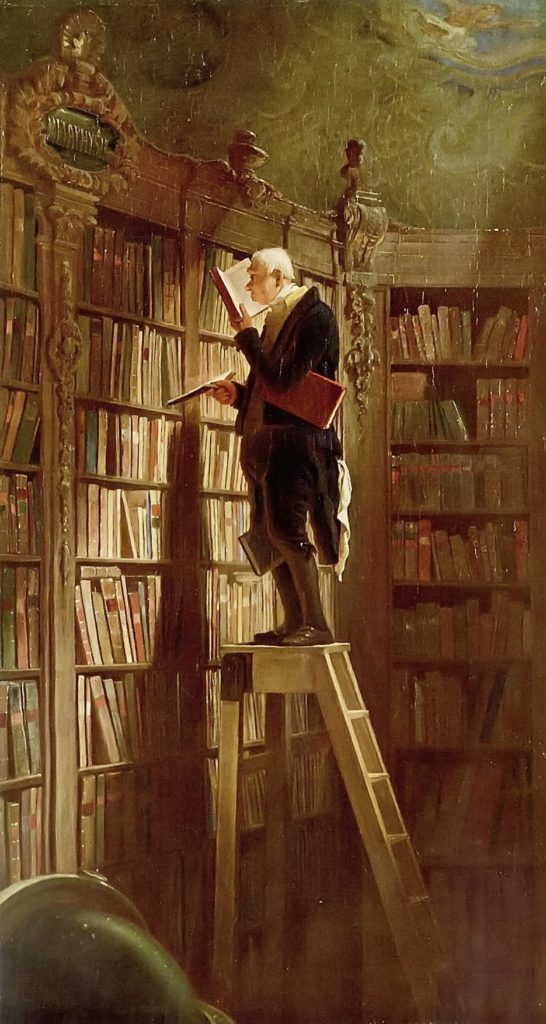
Tuesday
Today’s post is a belated celebration of Library Week (April 7-13), which generated several articles worthy of mention.
In a substantive New Review of Books essay (and what essay in that august publication is ever non-substantive?), Sue Halpern reviews several books about public libraries. I particularly liked an observation drawn both from her personal experiences and from Eric Klinenberg’s Palaces for the People: How Social Infrastructure Can Help Find Inequality, Polarization, and the Decline of Civic Life:
A public library is predicated on an ethos of sharing and egalitarianism. It is nonjudgmental. It stands in stark opposition to the materialism and individualism that otherwise define our culture. It is defiantly, proudly, communal. Even our little book-lined room, with its mismatched furniture and worn carpet, was, as the sociologist Eric Klinenberg reminds us libraries were once called, a palace for the people.
Halpern also quotes from a 1982 statement issued by the Public Library Association:
The public library is unique among our American institutions. Only the public library provides an open and nonjudgmental environment in which individuals and their interests are brought together with the universe of ideas and information…. The uses made of the ideas and information are as varied as the individuals who seek them. Public libraries freely offer access to their collections and services to all members of the community without regard to race, citizenship, age, education level, economic status, or any other qualification or condition.
Free access to ideas and information, a prerequisite to the existence of a responsible citizenship, is as fundamental to America as are the principles of freedom, equality and individual rights.
Klinenberg supports the statement with an observation on the role of public infrastructure:
“Infrastructure” is not a term conventionally used to describe the underpinnings of social life…[but] if states and societies do not recognize social infrastructure and how it works, they will fail to see a powerful way to promote civic engagement and social interaction, both within communities and across group lines.
Halpern’s article makes clear that public libraries, which continue to be very popular amongst most populations, promote civic engagement and social interaction in just these ways.
In the other article, New Yorker’s Kathy Schultz first describes what the New York Public Library meant to her father and then contrasts how he and her mother maintained their private libraries.
Because Schultz’s grandmother was one of the few in her family to escape Auschwitz, her father’s childhood was unhappy. Fortunately, he found refuge in the New York Public Library, and he passed his mania for reading onto his children by reading to them every night. While his wife categorized her books according to “thematic, alphabetic, and aesthetic demands” so that one needed “not only a card catalogue but a crowbar,” he just stacked them by his bed, with spectacular results:
The Stack had started in a recessed space near my father’s half of the bed, bounded on one side by a wall and on the other by my parents’ dresser, a vertical behemoth taller than I would ever be. At some point in the Stack’s development, it had overtopped that piece of furniture, whereupon it met a second tower of books, which, at some slightly later point, had begun growing up along the dresser’s other side. For some reason, though, the Stack always looked to me as if it had defied gravity (or perhaps obeyed some other, more mysterious force) and grown down the far side of the dresser instead. At all events, the result was a kind of homemade Arc de Triomphe, extremely haphazard-looking but basically stable, made of some three or four hundred books.
One of the books mentioned by Schultz caught my eye since I’ve just finished it myself: Wallace Stegner’s magnificent Angle of Repose. Schultz observes that the novel achieved its own angle of repose in the Stack, and the image fits. Among other things, the angle of repose is the angle at which gravel can be graded before it starts cascading. (The novel also portrays a decades-old marriage that teeters on the verge of dissolution without ever falling apart, which may have described the father’s childhood.)
A photograph of the Stack remains one of Schultz’s most prized pictures:
Strictly speaking, of course, that one isn’t a photograph of my father at all, and yet I can’t imagine a better image of the kinds of things that normally defy a camera. My father’s exuberant, expansive mind; the comic, necessary, generous-hearted compromises of my parents’ marriage; the origins of my own vocation—they are all there in the Stack, aslant among the books, those other bindings.
Schultz’s memoir is in part a memoir about a time when people had large book collections. She herself does and so do I, resembling her mother in my own organizing. When I merged my substantive library with that of my parents, I spent a week devising systems that would allow me to find any book that I needed with a minimum of fuss. Given the number of times I resort to these books for my blog posts, it would take me hours of searching if I did not have some kind of system.
To give you the big picture, my parents’ family room, which measures 30’x40’x14’, has books shelves reaching from waist-high cabinets to the ceiling. To reach the upper books, there are three library ladders. One wall is entirely filled with fiction, drama, and poetry, another half wall is filled with children’s books.
We increasingly appear denizens of an earlier age, however. My English professor son can fit all of his books into a few small bookshelves and my entrepreneur son has even fewer. Though both are voracious readers, both find Kindle and—yes–public libraries to be far more sensible, especially given how many times they’ve moved and may continue to move.
Someday they will inherit our books and, perhaps, give them away. At the moment, however, my mother is glad that they’ll be staying in the family for a while.

